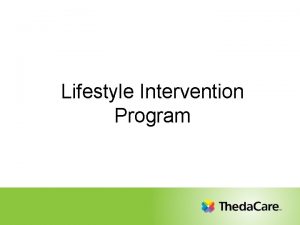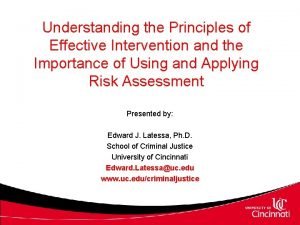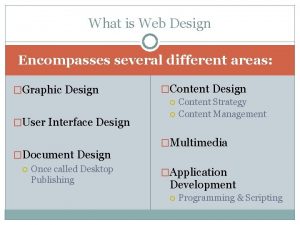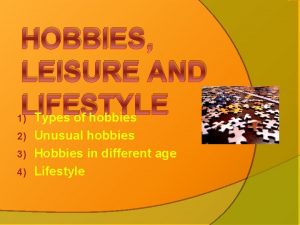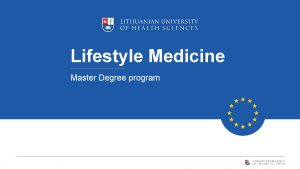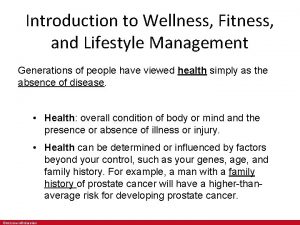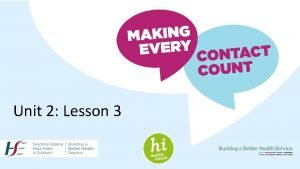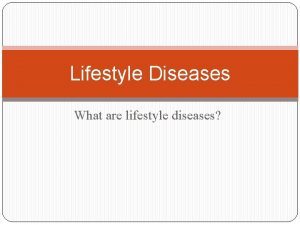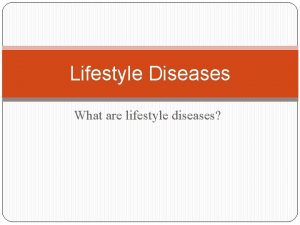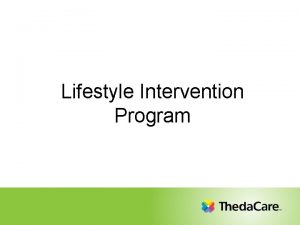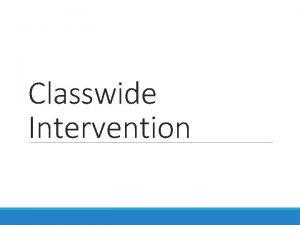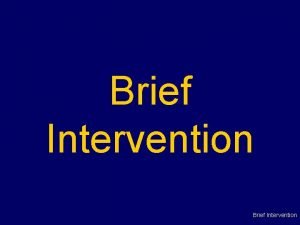Lifestyle Intervention Effective treatment emphasizes lifestyle intervention including














































- Slides: 46







Lifestyle Intervention

Effective treatment emphasizes lifestyle intervention, �including diet �physical activity, �emotional

How to Begin No two patients are alike, and being able to tailor interventions to the unique needs of each patient increases the likelihood of long-term success.

Patient assessment �Patient assessment typically includes �patient’s degree of obesity, �Diet �exercise �emotional problems �motivation to change.

The nutrition goals for the older person with DM �Maintenance of near-normal blood glucose levels �Achievement of optimal serum lipid levels �Provision of adequate caloric intake �Prevention and treatments of complications �Improvement of overall health


Advices on meal planning for older people �Eat less fat: less than 30% of total calories �Saturated fat to less than 10% �Eat less sugar �Eat less salt : no more than 3 g of sodium daily and 2 g or less in hypertension �Eat food with higher fiber: try to consume 20 -30 g daily








The standard diet for weight loss �includes a balanced, reduced-calorie plan, based � with a deficit of 500 to 1, 000 calories/day, leading to a safe, recommended loss of � 0. 45 to 0. 90 kg/wk

Physical exercise

Physical exercise �Slows the progression of DM �Improved weight control �Maintenance overall function: �Improved lipid profile �Improved muscle strength �Increase bone density �Improves balance and stability �Reduced stress �Regular physical activity for all older people with DM

Managing stress Physical activity is a particularly useful strategy for managing stress because it raises psychological well-being

Physical exercise �Avoid strenuous exercise because of the risk of : �Injury �Retinal detachment �or vitreous hemorrhage �hypoglycemia

Physical exercise �Should check their blood glucose before exercise and �Eat additional carb if glucose levels are below 100 mg/dl �To avoid hypoglycemia the older person : �May have carb food available during and after exercise. �Avoid exercise in FBS are greater than 250 mg/dl

Physical exercise �The best time is about 30 min to 1 hour after a meal �When exercise occurs more than 2 hours after eating : check blood sugar and if it is less than 120 eating or drinking something with about 15 -30 g carb �Take less insulin prior to meal � in hypoglycemia unawareness: exercise with someone who is aware of symptoms and can help

Physical exercise �Adequate hydration �Inspect the feet after exercise to check for blisters and or reddened areas �Good supportive shoes �Comfortable clothing �Checking the inside of shoes �Meet with his/her health care professional Before starting an exercise program

Recommended exercises �Walking �Swimming �Bicycling �Walking or swimming three times a week for 30 min �In inactive older : must to begin gradually �A safe place for walking and good footwear

complication Exercise to avoid s Rationale Choose instead Peripheral neuropathy Jogging Brisk walking climbing May cause foot trauma, turned ankles, falls Swimming Stationary bike Rowing machine automatic Neuropathy Strenuous or prolonged exercise Decreased cardiovascular response, postural hypotension Walking Swimming treadmill Proliferative retinopathy Jogging Skiing Body contact sports Heavy lifting Any use of breath holding May cause retinal detachment or hemorrhage in the back of the eye Walking Swimming Stationary bike nephropathy Strenuous or prolonged exercise May increase proteinuria Walking Swimming Cardiovascul ar disease Heavy lifting Any use of breath holding Strenuous or prolonged exercise May cause Swimming angina, &arrhythmia Stationary bike s, increased blood treadmill pressure if not well

For patients who do not appear motivated to change personalizing their risk factors— including a brief discussion about how modest weight loss may lower their elevated blood pressure, plasma lipid levels, or plasma glucose levels—can sometimes be helpful.

Encouragement from physicians can make a major difference in the lives of many patients.

Lifestyle Intervention Strategies

Setting goals �Setting easy-to-achieve short-term goals, such as increasing the number of steps or the number of minutes that a patient walks during the day, �and then focusing on the psychological feeling of enhanced well-being, can sometimes be quite motivating.

�Patients usually feel good about meeting modest goals and may be encouraged to try additional ones �Goals should be reevaluated regularly and revised as appropriate

�patients that trying to achieve unrealistic short-term goals, such as losing weight too quickly through highly restrictive dieting, can lead ultimately to weight regain and feelings of failure.

Raising awareness �The most important of all lifestyle intervention strategies for achieving and maintaining a healthful lifestyle is �self-monitoring, ie, raising awareness

�Self-monitoring involves �self-observation �self-recording �and feedback

Food and exercise diaries are the best way to achieve raising awareness

Accuracy is not crucial in their recording, as most patients tend to underestimate their energy intake by about one third and overestimate their expenditure by about one half

To increase awareness of body weight, weighing daily during the weight loss phase and weekly during long-term maintenance is also needed.

Confronting barriers Why is the older patients not eating healthfully and exercising regularly?

Providing support �Strong support from family members, close friends, colleagues, physicians, and others can be powerful for patients losing weight and maintaining a healthful lifestyle

�Support systems are successful because they provide �good role models �help in overcoming barriers to change, and �allow for self-acceptance.

www. rawfor 30 days. com DR. COUSENS' TREE OF LIFE CENTER US www. treeoflifecenterus. com (866) 394 -2520 686 Harshaw Road Patagonia, AZ 85624

Contracting involves having patients verbalize ≥ 1 healthful behavior that they agree to perform between visits Contracts can be especially useful in motivating short-term change.
 Thedacare lifestyle intervention program
Thedacare lifestyle intervention program Intervention treatment
Intervention treatment Nida principles of drug addiction treatment
Nida principles of drug addiction treatment Principles of effective intervention
Principles of effective intervention The single step income statement emphasizes
The single step income statement emphasizes Famous op art paintings
Famous op art paintings Statement of retained earnings
Statement of retained earnings The lowest level in maslow's hierarchy of needs emphasizes:
The lowest level in maslow's hierarchy of needs emphasizes: Jit manufacturing emphasizes
Jit manufacturing emphasizes The single-step income statement emphasizes
The single-step income statement emphasizes Police organization and management
Police organization and management Emotionalism art definition
Emotionalism art definition Situational theory of leadership
Situational theory of leadership Realistic writing emphasizes accuracy of detail
Realistic writing emphasizes accuracy of detail How many faces a square pyramid have
How many faces a square pyramid have The mutcd recommends the use of emergency vehicles
The mutcd recommends the use of emergency vehicles Animals including humans year 4
Animals including humans year 4 Including samuel discussion questions
Including samuel discussion questions Animals including humans year 6
Animals including humans year 6 All of the cds even the scratched one (is are) in this case
All of the cds even the scratched one (is are) in this case It encompasses several different aspects, including
It encompasses several different aspects, including Invertebrates including snails slugs and mussels
Invertebrates including snails slugs and mussels Animal that only eats plants
Animal that only eats plants Billy wigglestick
Billy wigglestick I.c.e method
I.c.e method Printed words including dialogue
Printed words including dialogue Invertebrates including snails slugs and mussels
Invertebrates including snails slugs and mussels Acrostic poem food
Acrostic poem food Gaa lifestyle
Gaa lifestyle Oxid wms
Oxid wms Endocrinologist lifestyle
Endocrinologist lifestyle Firstbeat lifestyle assessment
Firstbeat lifestyle assessment Types of nuclear medicine
Types of nuclear medicine Lifestyle performance profile
Lifestyle performance profile Planning gaa
Planning gaa How are giraffes long necks adapted to their lifestyle
How are giraffes long necks adapted to their lifestyle What was the nomadic lifestyle
What was the nomadic lifestyle Exercise health and lifestyle
Exercise health and lifestyle Lifestyle countable or uncountable
Lifestyle countable or uncountable Hobbies leisure and lifestyle
Hobbies leisure and lifestyle Masters in lifestyle medicine
Masters in lifestyle medicine Athen vs sparta
Athen vs sparta Introduction to wellness and fitness
Introduction to wellness and fitness Seventh day adventist church
Seventh day adventist church Unit 2 lifestyle
Unit 2 lifestyle Atkins lifestyle
Atkins lifestyle Domestic discipline contract
Domestic discipline contract
